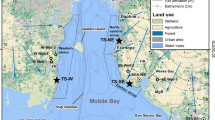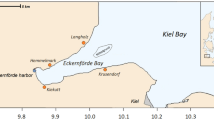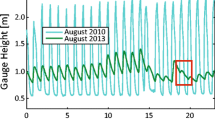Abstract
We performed a one-year study to determine the effects of on-site sewage disposal systems (OSDS, septic tanks) on the nutrient relations of limestone groundwaters and nearshore surface waters of the Florida Keys. Monitor wells were installed on canal residences with OSDS and a control site in the Key Deer National Wildlife Refuge on Big Pine Key. Groundwater and surface water samples were collected monthly during 1987 and analyzed for concentrations of dissolved inorganic nitrogen (DIN = NOf3/sup- + NOf2/sup- + NH4/su+), soluble reactive phosphate (SRP), temperature and salinity.
Significant nutrient enrichment (up to 5000-fold) occurred in groundwaters contiguous to OSDS; DIN was enriched an average of 400-fold and SRP some 70-fold compared to control groundwaters. Ammonium was the dominant nitrogenous species and its concentration ranged from a low of 0.77 μM in control wells to 2.75 mM in OSDS-enriched groundwaters. Concentrations of nitrate plus nitrite were also highly enriched and ranged from 0.05 μM in control wells to 2.89 mM in enriched groundwaters. Relative to DIN, concentrations of SRP were low and ranged from 30 nM in control wells to 107 μM in enriched groundwaters. N : P ratios of enriched groundwaters were consistently > 100 and increased with increasing distance from the OSDS, suggesting significant, but incomplete, adsorption of SRP by subsurface flow through carbonate substrata.
Nutrient concentrations of groundwaters also varied seasonally and were approximately two-fold higher during the winter (DIN = 1035 μM; SRP = 10.3 μM) compared to summer (DIN = 470 μM; SRP = 4.0 μM). In contrast, surface water nutrient concentrations were two-fold higher during the summer (DIN = 5.0 μM; SRP = 0.50 μM) compared to winter (DIN = 2.5 μM; SRP = 0.15 μM).
Direct measurement of subsurface groundwater flow rate indicated that tides and increased groundwater recharge enhanced flow some two-fold and six-fold, respectively. Accordingly, the observed seasonal coupling of OSDS-derived nutrients from groundwaters to surface waters is maximum during summer because of seasonally maximum tides and increased hydraulic head during the summer wet season. The yearly average benthic flux of anthropogenic DIN into contiguous canal surface waters is 55 mmol m-2 day-1, a value some five-fold greater than the highest rate of benthic N-fixation measured in carbonate-rich tropical marine waters.
Similar content being viewed by others
References
Baedecker MJ & Back W (1979) Modern marine sediments as a natural analog to the chemically stressed environment of a landfill. J. Hydrol. 43: 393–414
Berner RA (1981) Authigenic mineral formation resulting from organic matter decomposition in modern sediments. Fortschr. Miner. 59: 117–135
Brezonik PL (1972) Nitrogen: Sources and transformations in natural waters. In: Allen H & Kramer J (Eds) Nutrients in natural waters (pp 1–50) John Wiley and Sons, New York
Capone DG (1988) Benthic nitrogen fixation. In Blackburn TH & Sorensen J (Eds) Nitrogen Cycling in Coastal Environments, (pp 85–123) John Wiley and Sons, New York
Capone DG & Bautista MF (1985) A groundwater source of nitrate in nearshore marine sediments. Nature 313: 214–216
Champ DR, Gullens J & Jackson RE (1978) Oxidation-reduction sequences in groundwater flow systems. Can. J. Earth Sci. 16: 12–23
D'Elia CF, Webb KL & Porter JW (1981) Nitrate-rich groundwater inputs to Discovery Bay, Jamaica: A significant source of N to local coral reefs? Bull. of Mar. Sci. 31: 903–910
Driscoll FG (1986) Groundwater and Wells, 2nd ed. Johnson Division, St. Paul, MN
Dunstan WM & Menzel DW (1971) Continuous cultures of natural populations of phytoplankton in dilute, treated sewage effluent. Limnol. Oceanogr. 16: 623–632
Greenberg AE, Trussell RR & Clesceri LS (1985) Standard Methods for the Examination of Water and Wastewater. American Public Health Association, Washington, D.C.
Hanson CE (1980) Freshwater resources of Big Pine Key, Florida. U.S. Dept. of the Interior, Geological Survey, open-file report 80-447
Hoffmeister JE (1974) Land from the Sea. University of Miami Press, Miami, FL
Johannes RE (1980) The ecological significance of submarine discharge of groundwater. Mar. Ecol. Prog. Ser. 3: 365–373
Kerfoot WB (1988) Monitoring well construction, and recommended procedures for direct groundwater flow measurements using a heat-pulsing flowmeter. In: Collins AG & Johnson AI (Eds) Groundwater Contamination: Field Methods (pp 146–161) ASTM STP 963, American Society for Testing and Materials, Philadelphia, PA
Kohout FA (1960) Cyclic flow of salt water in the Biscayne aquifer of Southeastern Florida. J. of Geophys. Res 65: 2133–2141
Lapointe BE (1987) Phosphorus and nitrogen-limited photosynthesis and growth ofGracilaria tikvahiae (Rhodophyceae) in the Florida Keys: An experimental field study. Mar. Biol. 93: 561–568
Lapointe BE & O'Connell JD (1989) Nutrient-enhanced growth ofCladophora prolifera in Harrington Sound, Bermuda: eutrophication of a confined, phosphorus-limited marine ecosystem. Est. Coast. Shelf Sci. 28: 347–360
Lapointe BE (1989) Macroalgal production and nutrient relations in oligotrophic areas of Florida Bay. Bull Mar. Sci. 44: 312–323
Lewis JB (1985) Groundwater discharge onto coral reefs. Barbados, West Indies. Proc. 5th Int. Coral Reef Symp. 6: 477–481
Lewis JB (1987) Measurements of groundwater seepage flux onto a coral reef: Spatial and temporal variations. Limnol. Oceanogr. 32: 1165–1169
MacVicar TK (1983) Rainfall averages and selected extremes for central and south Florida. South Florida Water Management District, Technical publication No 83-2, West Palm Beach, Florida
Manheim FT (1967) Evidence for submarine discharge of water on the Atlantic continental slope of the southern United States and suggestions for further research. Trans. N.Y. Acad. Sci. Ser. II. 29: 839–853
Marmer HA (1954) Tides and sea level in the Gulf of Mexico. U.S. Fish Wildl. Serv. Fish. Bull 55: 101–118
Marsh JA (1977) Terrestrial inputs of nitrogen and phosphorus of fringing reefs of Guam Proc. 3rd Int. Coral Reef Symp. 1: 331–336
McComb AJ, Atkins RP, Birch PB, Gordon DM & Lukatelich RJ (1981) Eutrophication in the Peel-Harvey estuarine system, western Australia. In: Nielson BJ & Cronin LE (Eds) Estuaries and Nutrients (pp 323–342) Humana Press, Clifton, NJ
Murphy J & Riley JP (1962) A modified single solution method for determination of phosphate in natural waters. Anal. Chem. Acta. 26: 31–36
Orth RJ & van Montfrans J (1984) Epiphyte-seagrass relationships with an emphasis on micrograzing: a review. Aquat. Bot. 18: 43–69
Pattullo JC (1963) Seasonal changes in sea level. In: Hill MN (Ed), The Sea. Wiley, New York, NY
Rowe M (1984) The freshwater ‘central lens’ of Bermuda. J. of Hydrol. 73: 165–176
Segar D, Gerchakov S & Johnson T (1971) Chemistry. In: Bader RG & Roessler MA (Eds) An Ecological Study of South Biscayne Bay and Card Sound, Florida (pp IV1–V15) Prog. Rep. USAEC (AT40-1-3801-3) and Florida Power and Light Co., Coral Gables, FL
Simmons JAK, Jickells T, Knap A & Lyons WB (1985) Nutrient concentrations in groundwaters from Bermuda: Anthropogenic effects. In: Caldwell DE & Brierly JA (Eds) Planetary Ecology (pp 383–398) Van Nostrand Reinhold Company, Inc. NY
Simmons JAK (1987) Major and minor ion geochemistry of groundwaters from Bermuda. Ph.D. Dissertation, University of New Hampshire, Durham, New Hampshire
Slawyk G & MacIsaac JJ (1972) Comparison of two automated ammonium methods in a region of coastal upwelling. Deep Sea Res. 19: 521–524
Smith SV, Kimmerer WJ, Laws EA, Brock RE & Walsh TW (1981) Kaneohe Bay sewage diversion experiment: perspectives on ecosystem responses to nutritional perturbation. Pacific Science 35: 279–397
Strickland JDH & Parsons TR (1977) A Practical Handbook of Seawater Analysis. Alger Press, Ltd., Ottawa, Canada
Technicon (1973) Technicon AutoAnalyzer II, Industrial Methods. Technicon Industrial Systems, Tarrytown, NY
Visher FN & Mink JF (1964) Groundwater resources in Southern Oahu, Hawaii. U.S. Geological Survey. Water supply per. 1778
Von Bodungen B, Jickells TD, Smith SR, Ward JAD & Hillier GB (1982) The Bermuda Marine Environment, Vol. III. The final report of the Bermuda Inshore Waters Investigations 1975–1980. Bermuda Biological Station Special Publication No. 18
Wiebe WJ, Johannes RE & Webb KL (1975) Nitrogen fixation in a coral reef community. Science 188: 257–259
Zimmerman CF, Montgomery JR & Carlson PR (1985) Variability of dissolved reactive phosphate flux rates in nearshore estuarine sediments: Effects of groundwater flow. Estuaries 8: 228–236
Author information
Authors and Affiliations
Rights and permissions
About this article
Cite this article
Lapointe, B.E., O'Connell, J.D. & Garrett, G.S. Nutrient couplings between on-site sewage disposal systems, groundwaters, and nearshore surface waters of the Florida Keys. Biogeochemistry 10, 289–307 (1990). https://doi.org/10.1007/BF00003149
Published:
Issue Date:
DOI: https://doi.org/10.1007/BF00003149




